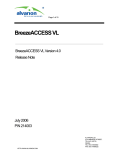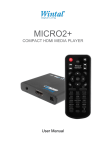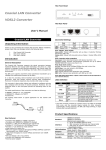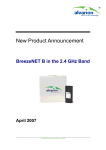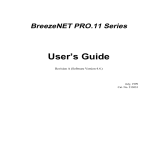Download BreezeNET B
Transcript
Page 1 of 8 BreezeNET B BreezeNET B Version 4.0 Release Note July 2006 P/N 214007 ALVARION LTD. 21A HABARZEL STREET, TEL AVIV, 69710, ISRAEL TEL: 972-3-6456262 FAX: 972-3-6456222 HTTP://WWW.ALVARION.COM Page 2 of 8 1. Introduction BreezeNET B version 4.0 introduces new products, new features and some problem fixes. 2. Frequency bands The currently supported frequency bands: • 5.725 – 5.850 GHz (5.8 band, FCC) • 5.470 – 5.725 GHz (5.4 band, ETSI) • 5.150 – 5.350 GHz (5.2 band) • 5.250 – 5.350 GHz (5.3 band, FCC) Starting in version 4.0, all BreezeNET B units are supplied as Base Units. Whenever necessary, the functionality of each unit can be changed from BU to RB and vice versa, using the Change Unit Type option in the Unit Control Menu. 3. New Products – BreezeNET B100 BreezeNET B100 (comprising of a BU-B100 and RB-B100 units pair), the new addition to the BreezeNET B product line, presents a point-to-point wireless system with unrivalled performance. The new BreezeNET B100 is currently available in the 5.4 and 5.8 GHz bands. BreezeNET B100 includes the following features and capabilities, which are not available in BreezeNET B14/28: 3.1. Enhanced Network Performances for Voice and data Unmatched Capacity The BreezeNET B100 can deliver up to an unmatched FTP throughput of more than 70Mbps*, making it the solution of choice for high-capacity point-to-point wireless applications. *utilizing 40MHz channels. Improved Concatenation Mechanism The improved concatenation mechanism enables concatenating more frames, providing an additional performance improvement for small packets traffic by eliminating the limitation on the number of ALVARION LTD. 21A HABARZEL STREET, TEL AVIV, 69710, ISRAEL TEL: 972-3-6456262 FAX: 972-3-6456222 HTTP://WWW.ALVARION.COM Page 3 of 8 frames that can be concatenated. The maximum size of a concatenated frame can be configured, enabling to optimize performance in accordance with the characteristics of the application being used. 3.2. Enhanced Support of Voice over IP and E1/T1 Wireless Link Prioritization The existing Traffic Prioritization mechanism takes care of prioritization of the traffic transmitted by each unit. The Wireless Link Prioritization mechanism complements the Traffic Prioritization mechanism by prioritizing traffic in the wireless medium, ensuring that transmissions of high priority traffic have precedence over transmissions of low priority traffic. The Wireless Link Prioritization feature enhances support of VoIP calls and other types of sensitive data, enabling appropriate handling of toll quality VoIP (high priority) together with best effort data (low priority). 3.3. Enhanced Security High Level Security with FIPS 197 Support (optional) An optional (under license) support of FIPS 197 enables using an encryption algorithm certified for compliance with Federal Information Processing Standards. 3.4. 1600 Bytes Packet Support In BreezeNET B100 units, the maximum length of an Ethernet packet that can be accepted from or transmitted to the Ethernet port (excluding CRC) is 1600 bytes, including VLAN. This enable running transparently large packet size protocols such as MPLS. ALVARION LTD. 21A HABARZEL STREET, TEL AVIV, 69710, ISRAEL TEL: 972-3-6456262 FAX: 972-3-6456222 HTTP://WWW.ALVARION.COM Page 4 of 8 4. New Features and Improvements for all BreezeNET B products 4.1. Enhanced Network Performances for Voice and data Improved Processing of Small Packets A drastic improvement in throughput with small packets provides unsurpassed capacity that positions the BreezeNET B as the undisputable best in the industry, with the extraordinary capability to process more than 40,000 packets per second, enabling at 64 bytes packets maximum product capacity with B14, 20Mbps with B28 and over 25Mbps with B100. Enhanced Prioritization with prevention of Low Priority Traffic Starvation The Low Priority Traffic Minimum Percent feature ensures that a certain amount of the traffic is reserved to low priority packets. This prevents complete starvation of low priority traffic when there is a high demand for high priority traffic. 4.2. Enhanced BU Tx Control A new option in the BU Tx Control enables automatically shutting down the transmitter when the Ethernet link is disconnected. This feature provides improved redundancy support since the RB will cease trying to synchronize with this BU and will immediately start searching for another BU. 4.3. Configurable Threshold for Lost Beacons Watchdog When it is unable to send beacon frames for a predetermined period of time, such as in the case of high interference level, the BU resets itself. The Lost Beacons Transmission Threshold parameter enables configuring the number of consecutive lost beacons after which the unit will reset itself, providing the means to avoid unneeded resets under relatively poor conditions. ALVARION LTD. 21A HABARZEL STREET, TEL AVIV, 69710, ISRAEL TEL: 972-3-6456262 FAX: 972-3-6456222 HTTP://WWW.ALVARION.COM Page 5 of 8 4.4. Enhancing Installer and Operator Experiences Reduced Cost and Complexity of Managing Inventory and spare parts through Unit Type Change Capability To simplify logistic operations, all units are supplied as Base Units. Whenever necessary, the functionality of each unit can be changed from BU to RB, and vice versa. Simpler Installation and Configuration Changes through Automatic SubBand Recognition The new User Defined Frequency Subsets option in the RB enables defining for each of the available Sub-Bands the frequencies that will be used by the RB when scanning for a BU. The RB is configured with a minimal set of parameters to ensure that it will be able to automatically detect and use the frequency/bandwidth used by the BU, including possible changes in the Sub-Band being used by the BU. This feature enables using Best BU mode and having an RB scanning and synchronizing with a BU without being configured in advanced to the proper BU sub band which may be of either 20 or 40 MHz channel width. Simpler Installation and Management through Uniform Transmit Power Parameters In previous versions, four different parameters were needed to define the Transmit Power (BU and RB) and Maximum Transmit Power (RB) parameters for the various modulation levels. The simplified process uses a single parameter for all modulation levels. In cases where this value exceeds the maximum permitted for a certain modulation level (due to either hardware or regulatory restrictions), the actual value will be automatically adapted to the applicable limitation. 5. BreezeCONFIG Configuration Utility Version 4.0 A new version of BreezeCONFIG that supports all the new features of BreezeNET B version 4.0 as well as the new BU/RB-B100 units is provided with the product. BreezeCONFIG SW will also be available in the customer service section of the Alvarion web site. ALVARION LTD. 21A HABARZEL STREET, TEL AVIV, 69710, ISRAEL TEL: 972-3-6456262 FAX: 972-3-6456222 HTTP://WWW.ALVARION.COM Page 6 of 8 6. Documentation The information in the release notes is complementary to the product documentation, provided with the products. BreezeNET B documentation includes the System Manual for BreezeNET B version 4.0, User Manual for BreezeCONFIG version 4.0, installation support documents, and release notes. All the documentation, including the latest release notes, is available in the customer service section of the Alvarion web site. 7. Compatibility and Interoperability Version 4.0 is fully compatible with versions 2.0, 3.0 and 3.1. Nevertheless, it is recommended to always upgrade existing equipment to the latest version. In links where the two units run different SW versions the performance will be determined by the unit with the lower SW version. The SW package will be available in the customer service section of the Alvarion web site. 8. Important Notes • Although minimum output power is defined as -10 dB when configuring the Tx Power manually, when ATPC is enabled the RB’s output power may be less than this minimum. • Extra care should be taken when configuring VLAN management and management IP filtering in order not to lose connectivity with unit. In case of connectivity loss, use the “restore default parameters” application to reset to factory values. • When Wireless Link Prioritization feature in BreezeNET B100 is activated, the Low Priority Traffic Minimum Percent feature is automatically disabled. • Upon downgrade from version 4.0 to version 3.0 or lower, all the information in the Network Management IP Address Ranges table will be lost. Hence, management access may be lost if the unit was managed from an IP address that is on a subnet defined in the new tables. • When upgrading from version 3.0 or lower to version 4.0, the high/low packet classification settings according to the old VLAN Priority Threshold or IP Precedence ALVARION LTD. 21A HABARZEL STREET, TEL AVIV, 69710, ISRAEL TEL: 972-3-6456262 FAX: 972-3-6456222 HTTP://WWW.ALVARION.COM Page 7 of 8 Threshold parameters will be lost. The new parameters are forced to the default value of 7, meaning no prioritization. • Remote changes of the Maximum Modulation Level in an RB while Adaptive Modulation is disabled may lead to lose of connectivity with the unit. The recommended workaround is to enable Adaptive Modulation, reset the unit to apply the change, and then change the Maximum Modulation Level. • Adaptive Modulation may not converge to best modulation in some setups with high variance in noise levels. In these cases better performances may be achieved with manual modulation settings (Adaptive Modulation Disabled). • Upon upgrade to SW version 4.0 from a lower version the FTP Client IP Address and Subnet Mask do no longer exist as configurable parameters and the unit's IP parameters are used instead. Upon downgrade from SW version 4.0 to a lower version the FTP Client IP Address of the unit is automatically set to the same value as the IP Address of the device. In this case following warning message appears: *** WARNING: Same 'Unit IP Address' and 'FTP Client IP Address'! *** *** 'FTP Client IP Address' ignored until change and reset! *** After downgrade it is recommended changing the FTP Client IP Address to 1.1.1.3 and the FTP Server IP Address to 1.1.1.4. • With Version 4.0 higher number of PHY ERR may be reported. The increase of reports is due increase in types of errors detected. This by itself is not affecting the functionality of the units but only showing information that was previously not available. Noisy environment will produce higher number of PHY ERR and these reports can be used to identify noisy channels. • SNMP management was checked with SNMPC version 5.1.11e. 9. Limitations & Known Issues • Sensitivity may change slightly as a function of frequency (+/-2dB). • Transmission power accuracy is +/-1dB above 8dBm @ antenna port (typical condition). At lower levels the accuracy is +/-3dBm, never contradicting regulations. At very low levels the use of ATPC may cause significant fluctuations in the power level of the transmitted signal. When operating at such low levels, it is recommended to disable the ATPC Option ALVARION LTD. 21A HABARZEL STREET, TEL AVIV, 69710, ISRAEL TEL: 972-3-6456262 FAX: 972-3-6456222 HTTP://WWW.ALVARION.COM Page 8 of 8 in the SU and to set the Transmit Power parameter to the average Tx Power level before the ATPC was disabled. • In units operating in the 5.3 GHz band, the following rules must be met for full compliance with FCC regulations: Transmit Power parameter in the BU when operating at 5270 MHz with a 20 MHz bandwidth, and the Maximum Tx Power parameter in the RB connected to this BU, should not be set to a value above “17-Antenna Gain” (The maximum allowed EIRP for 5270 MHz is 17 dBm). In units operating in “Turbo” mode (40 MHz bandwidth), frequency channels 5270 and 5280 MHz should not be used. • In units with HW Revision B, Burst Mode cannot be activated when using WEP for data encryption. In units with HW Revision B, the Burst Mode option will be “blocked” upon trying to enable it when using WEP for data encryption. This limitation does not apply to units with HW Revision C. • The following traps are not fully supported by the Trap Monitor of BreezeCONFIG: Ethernet Broadcast/Multicast Limiter Threshold Exceeded: The number of packets that were dropped is not displayed. Unit Type Changed: The new unit type is not displayed. The MAC address of the unit is displayed in the Associated SU/RB Mac Address column. • BreezeCONFIG does not support multiple configuration of frequency parameters and Spectrum Analysis. 10. • Fixed Issues In previous versions, the FTP Client IP Address was configurable, and the user was warned against attempting to configure this parameter with the same value as the unit’s IP address. Starting on version 4.0, the FTP Client IP Address is not configurable, and the fixed address is the same as the unit’s IP address. The default FTP Server IP Address has been changed to 10.0.0.253. • FTP frames are handled by the units as management frames, and they are processed accordingly by the relevant mechanisms such as VLAN and IP Filtering. ALVARION LTD. 21A HABARZEL STREET, TEL AVIV, 69710, ISRAEL TEL: 972-3-6456262 FAX: 972-3-6456222 HTTP://WWW.ALVARION.COM








